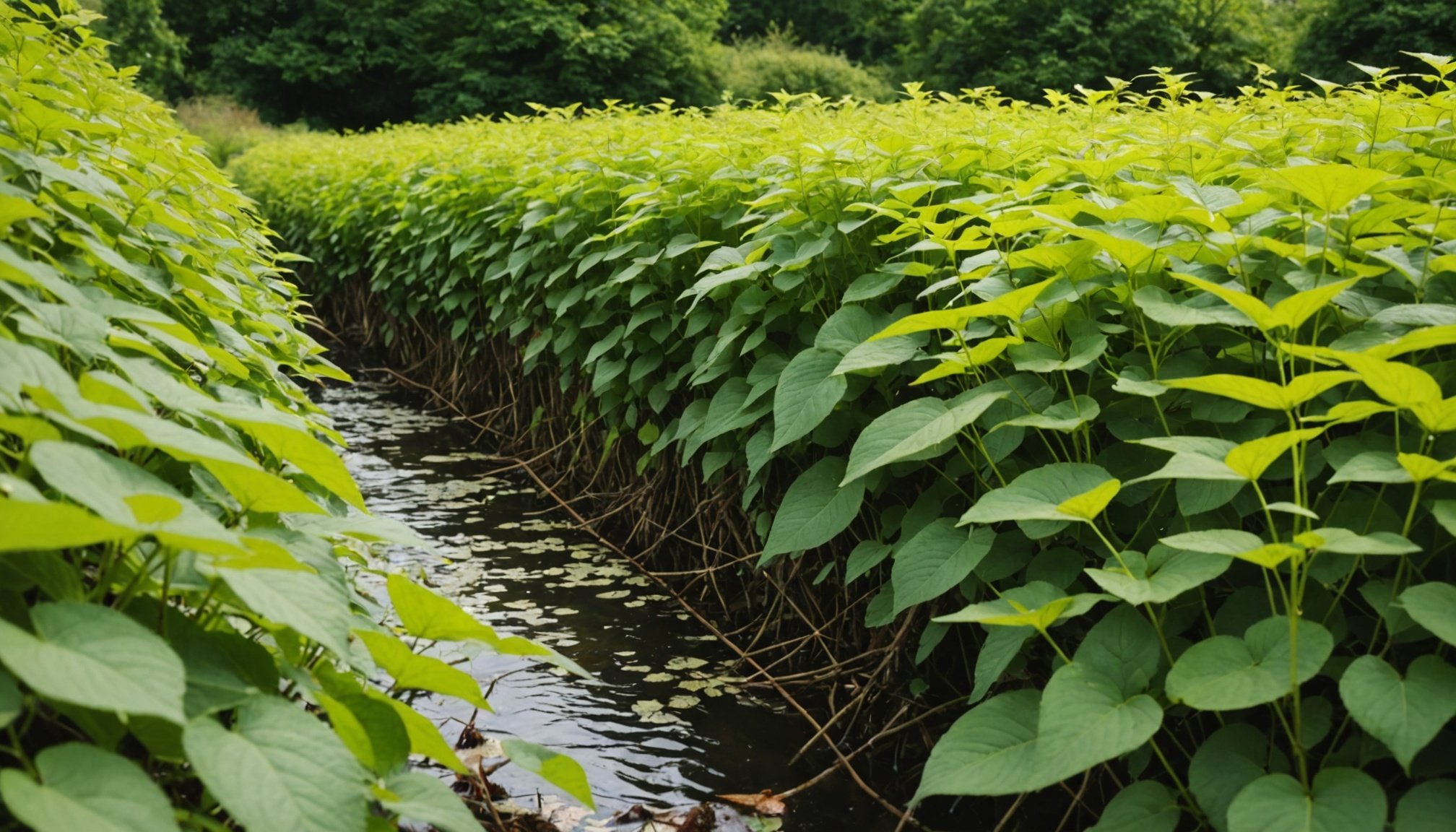Selling a home in the UK can be challenging, especially when it comes to dealing with Japanese knotweed. This invasive plant can significantly impact property value and the sale process. Understanding its implications and legal responsibilities is essential for any seller. This guide offers clear strategies to manage knotweed concerns, helping you make informed decisions that protect your investment and streamline your sales journey. Don't let this pesky plant derail your home sale; knowledge is your best ally.
Understanding Japanese Knotweed and Its Impact on Property Sales
Japanese Knotweed is a notorious invasive species known for its rapid growth and resilience. Originating from Asia, it can reach up to 3 meters in height, with roots extending deep into the ground. This aggressive plant poses significant challenges, particularly in the context of property sales. Its presence can substantially reduce property value and deter potential buyers due to the extensive damage it can cause to buildings and infrastructure.
Avez-vous vu cela : Top Insurance Solutions for Dual-Use Properties in the UK: Combining Home and Office Coverage
The impact of Japanese Knotweed on property sales is profound. Properties infested with this plant often see a decline in marketability, as buyers are wary of the potential costs associated with its removal and the structural damage it can inflict. Mortgage lenders may also be hesitant to finance properties affected by this invasive species, further complicating the sales process.
There are several misconceptions about Japanese Knotweed in real estate. One common fallacy is that its presence automatically renders a property unsellable. While it does present challenges, effective management and professional treatment can mitigate its impact. Another misconception is that it can be easily eradicated; in truth, it demands persistent and specialised treatment. Understanding these nuances is crucial for property owners and buyers navigating the real estate market.
En parallèle : Exploring the Impact of UK Regulations on High-Rise Residential Building Insurance
Legal Obligations for Sellers
When selling properties in the UK, understanding legal obligations is crucial, especially concerning Japanese Knotweed. Sellers are required to disclose the presence of this invasive plant through the Property Information Form (TA6). This document is a standard part of the property disclosure process and plays a vital role in informing potential buyers about any issues that might impact the property's value or condition.
Failing to disclose Japanese Knotweed can lead to significant consequences. Sellers may face legal action from buyers if the infestation is discovered post-sale, leading to costly settlements or repairs. Additionally, nondisclosure can damage a seller's credibility and complicate future property transactions.
The TA6 form specifically asks about the presence of Japanese Knotweed, ensuring that sellers provide accurate information. This transparency is essential not only for legal compliance but also for maintaining trust in the real estate market. Buyers rely on these disclosures to make informed decisions, highlighting the importance of honesty and thoroughness in the selling process.
In summary, adhering to legal obligations and completing the TA6 form accurately is imperative for sellers. It safeguards against potential legal disputes and helps maintain a fair and transparent property market.
Assessing the Presence of Japanese Knotweed
Identifying Japanese Knotweed on your property is crucial before proceeding with any sale. This invasive plant can be recognised by its bamboo-like stems, heart-shaped leaves, and white flowers. During spring, it emerges with reddish-purple shoots, growing rapidly into dense thickets. To ensure accurate identification, hiring a qualified surveyor is recommended. These professionals are skilled in conducting comprehensive property assessments to detect the presence of Knotweed.
A professional surveyor will look for specific signs that may indicate a Knotweed infestation. These include:
- Dense clumps of reddish-purple shoots in spring.
- Hollow, bamboo-like stems with distinct nodes.
- Rapid growth and spread, often forming dense thickets.
- Heart or shovel-shaped leaves arranged in a zig-zag pattern.
Conducting a thorough property assessment is essential, as misidentification can lead to unnecessary panic or missed infestations. Surveyors can provide detailed reports that outline the extent of the infestation and recommend management strategies. Engaging a professional not only aids in accurate identification but also provides peace of mind for both sellers and potential buyers. Proper assessment ensures informed decision-making and helps maintain the integrity of the real estate transaction.
Treatment and Removal Options
Understanding the treatment methods for Japanese Knotweed is essential for effective management. There are both chemical and non-chemical approaches available, each with its own advantages. Chemical treatments typically involve herbicides, which are applied over several growing seasons to ensure thorough eradication. These methods are often preferred for their effectiveness, though they require careful application to avoid environmental harm.
Non-chemical methods include physical removal and root barriers. Physical removal involves excavating the plant and its extensive root system, which can be labor-intensive and costly. Root barriers, on the other hand, are used to contain the spread and prevent new growth, offering a sustainable solution without chemicals.
Professional services play a crucial role in the treatment and removal of Japanese Knotweed. Engaging experts ensures that the most suitable method is chosen and applied correctly. Professionals can also provide a management plan tailored to the specific needs of the property, offering peace of mind to property owners.
The expected timelines and costs for treatment can vary. Chemical treatments may take several years, while physical removal is immediate but more expensive. Costs depend on the infestation's size and location, making professional assessment invaluable for accurate estimates.
Communicating with Potential Buyers
Effective buyer communication is vital when dealing with properties affected by Japanese Knotweed. Transparency is key. Begin by openly disclosing the presence of Knotweed early in the property marketing process. This honesty not only builds trust but also sets realistic expectations for potential buyers.
When discussing treatment plans, provide detailed documentation. Outline the steps taken for Knotweed management, including any professional services employed. Highlight the long-term benefits of these measures, such as increased property value and reduced future risks. This approach reassures buyers about the property's condition and the commitment to resolving the issue.
Maintaining buyer trust during negotiations involves clear and consistent communication. Address any concerns promptly and provide evidence of successful management strategies. Consider offering guarantees or warranties from professional treatment providers, which can further instil confidence in the property's future stability.
Incorporating these best practices into your communication strategy can significantly enhance buyer perception. By being forthright about Knotweed and proactive in presenting solutions, sellers can navigate the complexities of real estate transactions with integrity and confidence. This approach not only facilitates smoother negotiations but also contributes to a healthier, more transparent property market.
Market Perception of Japanese Knotweed
Understanding the market perception of Japanese Knotweed is crucial for property sellers and buyers alike. This invasive plant significantly influences buyer concerns, often leading to hesitancy and scepticism in the real estate market. Buyers are typically wary of the potential structural damage and financial implications associated with Knotweed, affecting their willingness to invest.
Recent trends indicate that properties affected by Japanese Knotweed typically experience a decline in property values. However, the extent of this decline can vary based on the severity of the infestation and the effectiveness of management strategies. In some cases, properties have seen a reduction in value by up to 10%, while others have managed to maintain their worth through proactive treatment and transparent communication.
Examining case studies reveals diverse outcomes. Successful sales often involve comprehensive Knotweed management plans and clear communication with potential buyers. For instance, properties that provided detailed treatment records and guarantees from professional services generally achieved more favourable outcomes. Conversely, unsuccessful sales typically lacked transparency or failed to address buyer concerns adequately, leading to prolonged market listings or reduced offers. Addressing these factors is essential for navigating the complexities of selling properties affected by Japanese Knotweed.
Navigating Mortgage and Insurance Issues
Dealing with Japanese Knotweed can complicate mortgage approvals and insurance policies. Lenders are often cautious, as the plant's presence can affect a property's structural integrity, leading to potential devaluation. This caution results in stricter mortgage implications, where lenders may refuse to finance or impose higher interest rates unless a comprehensive management plan is in place.
When it comes to insurance concerns, many providers are hesitant to cover properties with Knotweed. The risk of damage and the costs associated with its removal are significant factors. Insurers may require proof of effective treatment or a guarantee from a professional service before issuing a policy. Without this, securing coverage can be challenging.
To improve your chances of securing financing, consider these tips:
- Obtain a detailed Knotweed management plan from a reputable specialist.
- Ensure the plan includes regular monitoring and treatment updates.
- Provide lenders and insurers with documentation showing proactive measures.
By addressing these financing challenges head-on, property owners can navigate the complexities of mortgage and insurance issues. Demonstrating commitment to managing Japanese Knotweed effectively reassures both lenders and insurers, facilitating smoother transactions and securing necessary financial support.
Long-term Management Strategies
Ensuring a Knotweed-free property requires diligent long-term management and consistent property maintenance. After initial treatment, it is crucial to implement regular monitoring strategies to prevent recurrence. Property owners should conduct periodic inspections, especially during the growing season, to identify any signs of regrowth. Early detection allows for prompt intervention, reducing the risk of a full-blown infestation.
Prevention is key in maintaining a Knotweed-free environment. Implementing barriers and maintaining a tidy landscape can deter the spread of this invasive species. Regularly trimming plants and removing debris can minimise potential growth sites. Additionally, educating residents and neighbours about Knotweed can help in community-wide prevention efforts.
Documenting the treatment history is vital for future property sales. Detailed records of management strategies, including dates and methods used, provide transparency to potential buyers. This documentation reassures them of the property's condition and the commitment to maintaining it. Furthermore, having a comprehensive treatment history can facilitate smoother real estate transactions by addressing buyer concerns proactively.
By focusing on long-term management, prevention, and thorough documentation, property owners can effectively manage Japanese Knotweed, ensuring their property's value and integrity remain intact.
Resources and Support for Homeowners
Navigating the challenges of Japanese Knotweed can be daunting for homeowners, but numerous resources and support networks are available to offer guidance. Various organisations and websites provide invaluable information to help manage this invasive plant effectively. For instance, the Royal Horticultural Society (RHS) offers detailed guidance on identification and treatment methods. Their resources are especially beneficial for those seeking practical advice tailored to UK conditions.
Legal advice is crucial when dealing with Knotweed issues. Homeowners can access support from legal firms specialising in property law and environmental issues. These experts can offer insights into legal obligations, potential liabilities, and strategies to protect property value. Additionally, some local councils provide resources and may offer advice on local regulations concerning Knotweed management.
Community support networks also play a significant role in assisting affected homeowners. Online forums and local gardening clubs often serve as platforms for sharing experiences and solutions. Engaging with these communities can provide emotional support and practical tips from others who have successfully managed Knotweed infestations. By leveraging these resources and support systems, homeowners can navigate the complexities of Knotweed management with greater confidence and effectiveness.
Conclusion and Next Steps
When selling property with Knotweed, crafting an effective action plan is crucial. Start by engaging a professional surveyor to confirm the presence and extent of the infestation. This provides a clear basis for planning treatment and communicating with potential buyers.
Proactive management of Japanese Knotweed is essential. Implement a comprehensive treatment strategy, whether through chemical or non-chemical methods, and document every step. This transparency is vital for building buyer trust and ensuring smoother negotiations. Providing detailed records of treatment and management plans can reassure buyers of the property's stability and your commitment to resolving the issue.
Effective communication is another key aspect. Be upfront about the Knotweed situation from the start, offering potential buyers a clear picture of the property's condition and the measures taken to address the problem. This openness not only builds trust but also demonstrates responsibility and transparency.
Finally, seeking professional advice and support throughout the process is highly recommended. Legal experts, surveyors, and treatment specialists can provide invaluable guidance, helping you navigate the complexities of selling a property affected by Japanese Knotweed. With the right approach, you can mitigate risks and maintain the property's value, ensuring a successful sale.











